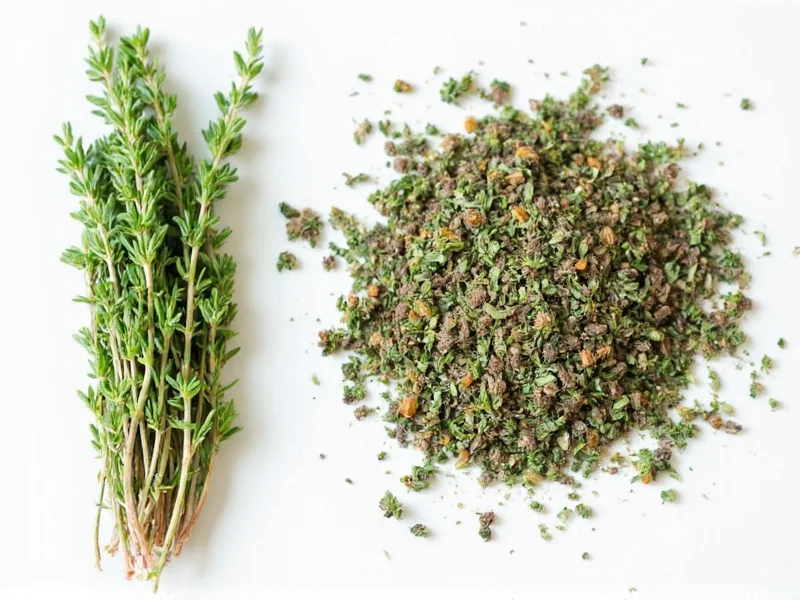Understanding herb conversions is essential for consistent cooking results. When substituting fresh thyme for dried in recipes, or vice versa, getting the measurements right makes the difference between a perfectly seasoned dish and one that's overpowering or bland.
Why the 3:1 Fresh to Dry Thyme Conversion Ratio?
Thyme undergoes significant chemical changes during the drying process. Fresh thyme contains approximately 85% water, while dried thyme has only about 10% moisture content. As the water evaporates, the essential oils and flavor compounds become more concentrated.
This concentration explains why you need less dried thyme than fresh to achieve equivalent flavor. The 3:1 ratio (three parts fresh to one part dried) has been established through culinary testing and represents the standard conversion used by professional chefs and food scientists.
Fresh to Dry Thyme Conversion Chart
| Fresh Thyme | Dried Thyme | Equivalent Measurement |
|---|---|---|
| 1 tablespoon | 1 teaspoon | Basic conversion ratio |
| 3 tablespoons | 1 tablespoon | For stronger recipes |
| 1 sprig (about 1 inch) | ¼ teaspoon | Individual sprig conversion |
| 1 cup packed | ⅓ cup | Large quantity conversion |
When to Adjust the Standard Conversion
While the 3:1 ratio serves as a reliable starting point for fresh to dry thyme conversion, certain factors may require adjustments:
- Recipe cooking time: For dishes that simmer for hours, reduce dried thyme by 25% as flavors intensify over time
- Thyme variety: Lemon thyme and other specialty varieties may have different potency levels
- Storage duration: Dried thyme loses potency after 6-12 months; older herbs may require slightly more
- Dish acidity: In highly acidic recipes (like tomato sauces), increase dried thyme by 10-15%
Fresh vs. Dried Thyme: Best Culinary Applications
Understanding when to use each form enhances your cooking:
When to Use Fresh Thyme
- Finishing dishes where visual appeal matters (garnishes, salads)
- Short-cooking recipes (omelets, quick sautés)
- Delicate dishes where subtle herbal notes are preferred
- When you want a brighter, grassier flavor profile
- Infusing liquids for short periods (butter sauces, quick marinades)
When Dried Thyme Works Better
- Long-simmering dishes (stews, braises, soups)
- Dry rubs and spice blends
- Baking applications (breads, savory pastries)
- When fresh herbs aren't available
- Recipes requiring concentrated herbal flavor
Proper Storage for Maximum Flavor Retention
To maintain accurate fresh to dry thyme conversion ratios in your cooking, proper storage is essential:
Storing Fresh Thyme
Wrap fresh thyme sprigs in a slightly damp paper towel and store in a perforated plastic bag in the refrigerator crisper drawer. Properly stored, fresh thyme maintains peak flavor for 10-14 days. Avoid washing until ready to use, as excess moisture accelerates spoilage.
Storing Dried Thyme
Keep dried thyme in an airtight container away from light, heat, and moisture. A cool, dark pantry is ideal. Properly stored, dried thyme retains optimal flavor for 6-12 months. After this period, you may need to increase quantities slightly when converting from fresh measurements.
Common Fresh Thyme Substitutions
If you don't have the required form of thyme, these substitutions work well:
- Fresh thyme unavailable? Use 1 teaspoon dried thyme per tablespoon of fresh called for
- Dried thyme unavailable? Triple the amount of fresh thyme when substituting
- No thyme at all? Oregano (use 25% less) or marjoram (use equal amount) make acceptable substitutes
- For delicate dishes Try a combination of equal parts rosemary and oregano (use 25% less than thyme)
Professional Chef Tips for Herb Conversion
Master chefs follow these guidelines when working with fresh and dried thyme:
- Add dried thyme early in the cooking process to allow flavors to bloom
- Crush dried thyme between your fingers before adding to release essential oils
- Add fresh thyme toward the end of cooking to preserve delicate flavors
- For soups and stews, tie fresh thyme sprigs with kitchen twine for easy removal
- When in doubt, start with less dried thyme—you can always add more but can't remove excess
Measuring Techniques for Accurate Conversion
How you measure affects your fresh to dry thyme conversion accuracy:
- For fresh thyme: Strip leaves from stems and lightly pack into measuring spoon
- For dried thyme: Spoon lightly into measuring spoon without packing
- Never substitute by stem length—measure by leaf volume
- When converting sprigs to measurements: 1 sprig ≈ 1 inch of stem with leaves = ¼ teaspoon dried
- For large batches: Weigh thyme (1 ounce fresh ≈ 0.3 ounces dried)











 浙公网安备
33010002000092号
浙公网安备
33010002000092号 浙B2-20120091-4
浙B2-20120091-4